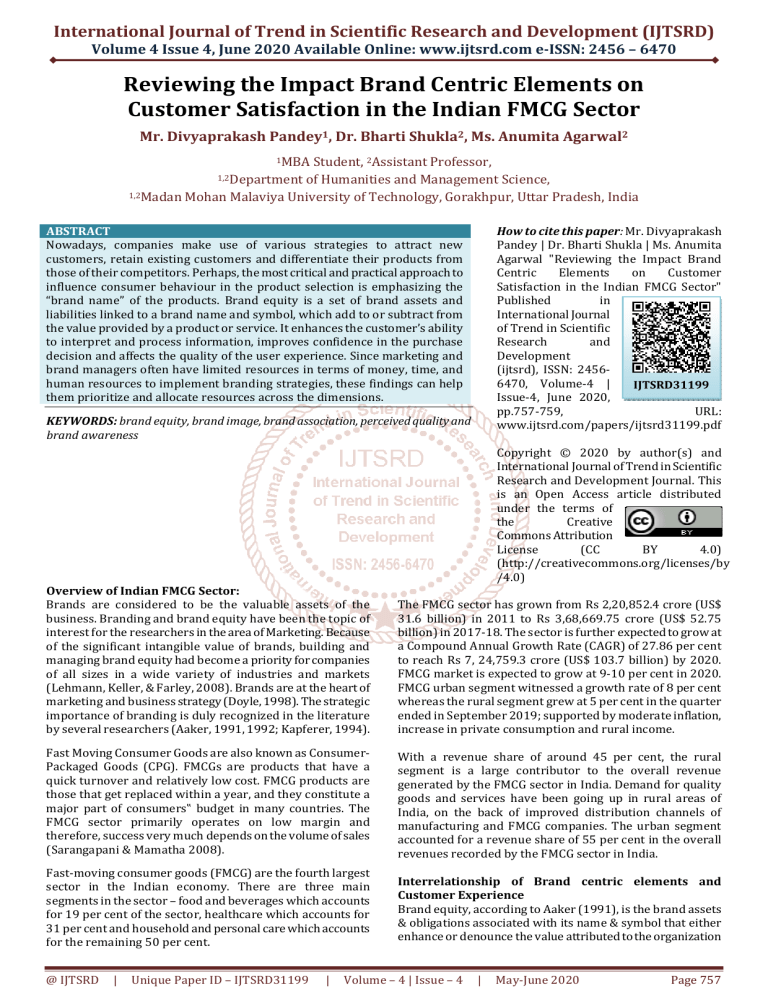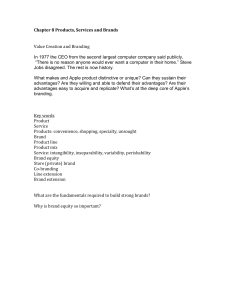
International Journal of Trend in Scientific Research and Development (IJTSRD)
Volume 4 Issue 4, June 2020 Available Online: www.ijtsrd.com e-ISSN: 2456 – 6470
Reviewing the Impact Brand Centric Elements on
Customer Satisfaction in the Indian FMCG Sector
Mr. Divyaprakash Pandey1, Dr. Bharti Shukla2, Ms. Anumita Agarwal2
1MBA
Student, 2Assistant Professor,
1,2Department of Humanities and Management Science,
1,2Madan Mohan Malaviya University of Technology, Gorakhpur, Uttar Pradesh, India
How to cite this paper: Mr. Divyaprakash
Pandey | Dr. Bharti Shukla | Ms. Anumita
Agarwal "Reviewing the Impact Brand
Centric
Elements
on
Customer
Satisfaction in the Indian FMCG Sector"
Published
in
International Journal
of Trend in Scientific
Research
and
Development
(ijtsrd), ISSN: 24566470, Volume-4 |
IJTSRD31199
Issue-4, June 2020,
pp.757-759,
URL:
www.ijtsrd.com/papers/ijtsrd31199.pdf
ABSTRACT
Nowadays, companies make use of various strategies to attract new
customers, retain existing customers and differentiate their products from
those of their competitors. Perhaps, the most critical and practical approach to
influence consumer behaviour in the product selection is emphasizing the
“brand name” of the products. Brand equity is a set of brand assets and
liabilities linked to a brand name and symbol, which add to or subtract from
the value provided by a product or service. It enhances the customer’s ability
to interpret and process information, improves confidence in the purchase
decision and affects the quality of the user experience. Since marketing and
brand managers often have limited resources in terms of money, time, and
human resources to implement branding strategies, these findings can help
them prioritize and allocate resources across the dimensions.
KEYWORDS: brand equity, brand image, brand association, perceived quality and
brand awareness
Copyright © 2020 by author(s) and
International Journal of Trend in Scientific
Research and Development Journal. This
is an Open Access article distributed
under the terms of
the
Creative
Commons Attribution
License
(CC
BY
4.0)
(http://creativecommons.org/licenses/by
/4.0)
Overview of Indian FMCG Sector:
Brands are considered to be the valuable assets of the
business. Branding and brand equity have been the topic of
interest for the researchers in the area of Marketing. Because
of the significant intangible value of brands, building and
managing brand equity had become a priority for companies
of all sizes in a wide variety of industries and markets
(Lehmann, Keller, & Farley, 2008). Brands are at the heart of
marketing and business strategy (Doyle, 1998). The strategic
importance of branding is duly recognized in the literature
by several researchers (Aaker, 1991, 1992; Kapferer, 1994).
The FMCG sector has grown from Rs 2,20,852.4 crore (US$
31.6 billion) in 2011 to Rs 3,68,669.75 crore (US$ 52.75
billion) in 2017-18. The sector is further expected to grow at
a Compound Annual Growth Rate (CAGR) of 27.86 per cent
to reach Rs 7, 24,759.3 crore (US$ 103.7 billion) by 2020.
FMCG market is expected to grow at 9-10 per cent in 2020.
FMCG urban segment witnessed a growth rate of 8 per cent
whereas the rural segment grew at 5 per cent in the quarter
ended in September 2019; supported by moderate inflation,
increase in private consumption and rural income.
Fast Moving Consumer Goods are also known as ConsumerPackaged Goods (CPG). FMCGs are products that have a
quick turnover and relatively low cost. FMCG products are
those that get replaced within a year, and they constitute a
major part of consumers‟ budget in many countries. The
FMCG sector primarily operates on low margin and
therefore, success very much depends on the volume of sales
(Sarangapani & Mamatha 2008).
With a revenue share of around 45 per cent, the rural
segment is a large contributor to the overall revenue
generated by the FMCG sector in India. Demand for quality
goods and services have been going up in rural areas of
India, on the back of improved distribution channels of
manufacturing and FMCG companies. The urban segment
accounted for a revenue share of 55 per cent in the overall
revenues recorded by the FMCG sector in India.
Fast-moving consumer goods (FMCG) are the fourth largest
sector in the Indian economy. There are three main
segments in the sector – food and beverages which accounts
for 19 per cent of the sector, healthcare which accounts for
31 per cent and household and personal care which accounts
for the remaining 50 per cent.
Interrelationship of Brand centric elements and
Customer Experience
Brand equity, according to Aaker (1991), is the brand assets
& obligations associated with its name & symbol that either
enhance or denounce the value attributed to the organization
@ IJTSRD
|
Unique Paper ID – IJTSRD31199
|
Volume – 4 | Issue – 4
|
May-June 2020
Page 757
International Journal of Trend in Scientific Research and Development (IJTSRD) @ www.ijtsrd.com eISSN: 2456-6470
by its product or services. Keller (1993) considers it as the
variation of customer perception caused by brand knowledge
& behaviour of a brand. There are four dimensions of brand
equity, brand awareness, brand association, perceived quality
& brand loyalty. Brand loyalty is one of the aspects of brand
equity. It represents how far the customer is intact to a
specific brand (Keller, 1993).
Brand awareness is the ability of the customer to remember
or identify a brand. One of the essential aspects that help the
customers to remember and prefer a brand is his direct
experience with a brand (Rossieter and Piercy, 1997).
Customer experience memory affects how we recall a brand
and identify it (Hoch, 2002). Also, the more we repeat our
experience with a brand, the higher the possibility of
recognition and retention of its name in customer memory
(Alba and Hutchinson, 1987). Also, positive experience in
service enhances brand recall & overall brand awareness
(Berry, 2000). Consumers’ brand awareness plays an
essential role in the decision-making process (Keller, 1993).
Brand image is very much crucial to retain the customers and
gain competitive advantage. Cretu and Brodie (2007), the
image of the brand has a favourable impact on the loyalty of
the customer and their perceptions of value.
Perceived quality is the customer’s perception of brand
superiority is performing compared to other products.
Perceived performance is closely related to quality
perception. Consequently, trial and experience with a product
do affect its overall quality assessment (Paswan and Ganesh,
2004). Perceived brand quality is an outcome of merchandise
associated with physical traits driven by cognitive &
Utilitarian criteria (Zeithaml, 1988).
Results and Discussions
Table 1: Item Statistics
Mean Std. Deviation
PERCEIVED QUALITY
3.4414
0.67689
BRAND ASSOCIATION
3.8588
0.78522
CUSTOMER SATISFACTION 3.8080
0.85627
BRAND IMAGE
3.7750
0.89982
BRAND AWARENESS
3.7850
0.88114
Source: Primary Data
Thus, all the five factors reviewed in this work show a
moderate agreement from the respondent’s side. This can be
observed from the mean and standard deviation values
computed.
Conclusion
Marketing of FMCGs plays a pivotal role in the growth and
development of a country irrespective of the size and
population. It is a fact that the development of FMCG
marketing has always kept pace with the economic growth of
India. Although the literature identifies several dimensions of
brand equity from different other industries, existing
research on brand equity in the FMCG industry is still spare.
Despite the growing importance of the Indian FMCG industry,
the topic of how the different FMCG products build brand
equity appears to be under-researched. The results of this
research also lead to a deeper understanding of an FMCG
brand equity concept, as well as some implications for
practitioners working in the FMCG industry.
References
[1] Aaker, D. A. (1991). Managing Brand Equity:
Capitalizing on the Value of a Brand Name. New York:
The Free Press.
Perceived brand quality is antecedent of trust (Botton &
Lemon, 1999; Coulter and Coulter, 2003; Ganesan & Hess,
1997; Johnson et al., 2006; Palmatier et al., 2006). In a study
conducted in France on the goods market, on Ice creams and
frozen food. The study did show a direct relationship
between perceived quality and trust and an indirect
relationship with loyalty (Aurier & Lanauze, 2009).
[2] Alba, J. W. and Hutchinson, J. W. (1987), Dimensions of
consumer expertise. Journal of Marketing, 13 (4): 411 –
454.
Brand associations are the image that the brand imposes that
is unique to a brand. Associations are built based on their
nature and level of abstract (Keller, 1993). In a service
perspective, we consider associations that are related to
service company image as corporate based associations,
which is based on the customer’s service experience.
Corporate based associations in services are related to the
company itself so that the company becomes a brand for
consumers (Berry, 2000). However, such associations vary
among different service industries as branding strategies
vary; for example, in the hotel industry, it is line branding. At
the same time, in banking, it is defined as corporate level
branding (Devlin, 2004).
[4] Aurier, P., & Séré de Lanauze, G. (2012). Impacts of
perceived brand relationship orientation on attitudinal
loyalty: An application to reliable brands in the
packaged goods sector. European Journal of Marketing,
46(11/12), 1602-1627.
Research Methodology
As per the data collected from primary and secondary
sources, SPSS software was utilized to calculate the mean and
standard deviation of the responses recorded from the
measurement scales incorporated in the research
questionnaire containing 200 responses from the survey.
Secondary sources have been supportive and vital in
resolving the objective under study.
@ IJTSRD
|
Unique Paper ID – IJTSRD31199
|
[3] Ali, F., and Muqadas, S., 2015. The Impact of Brand
Equity on Brand Loyalty: The Mediating Role of
Customer Satisfaction, Pakistan Journal of Commerce
and Social Sciences, 9 (3), pp. 890-915.
[5] Berry, L. (2000), “Cultivating service brand equity”,
Journal of the Academy of Marketing Science, Vol. 28
No. 1, pp. 128-137.
[6] Bloemer J and De Ruyter K (1998) On the relationship
between store image, store satisfaction and store
loyalty. European Journal of Marketing, 32(5/6): 499–
513.
[7] Bloemer J, De Ruyter K and Peeters P (1998)
Investigating drivers of and satisfaction. The
International Journal of Bank Marketing, 16(7): 276 –
286.
[8] Bloemer J, Ruyter KD and Peeters P (1998) Investigating
drivers of bank loyalty: The complicated relationship
between image, service quality and satisfaction.
International J. Bank Marketing, 16(7): 276-286.
Volume – 4 | Issue – 4
|
May-June 2020
Page 758
International Journal of Trend in Scientific Research and Development (IJTSRD) @ www.ijtsrd.com eISSN: 2456-6470
[9] Bolton, R.N. and Lemon, K.N. (1999), “A dynamic model
of customer’s usage of services: usage as an antecedent
and consequence of satisfaction”, Journal of Marketing
Research, Vol. 36 No. 2, pp. 171-86.
[10] Coulter, K.S. and Coulter, R.A. (2003), “The effects of
industry knowledge on the development of trust in
service relationships”, International Journal of Research
in Marketing, Vol. 20 No. 1, pp. 31-44.
[11] Cretu AE and Brodie RJ (2007) The influence of brand
image and company reputation where manufacturers
market to small firms: A customer value perspective.
Industrial Marketing Management, 36: 230-240.
[12] Cronin, J. J., Brady, M. K., and Hult, G. T. M., 2000.
Assessing the effects of quality, value, and customer
satisfaction on consumer behavioural intentions in
service environments. Journal of Retailing, 76 (2), pp.
193-218.
[13] Devlin, J. (2004), “Choice criteria in banking: an analysis
of trends”, Journal of Strategic Marketing, Vol. 12 No. 1,
pp. 13-28.
[14] Ekinci, Y. 2001. The validation of the general service
quality dimensions: An alternative approach. Journal of
Retailing and Consumer Services, 8 (6), pp. 311-324.
[15] Ganesan, S. and Hess, R. (1997), “Dimensions and levels
of trust: implications for commitment to a relationship”,
Marketing Letters, Vol. 8 No. 4, pp. 439-48.
[16] Gómez, M. I., McLaughlin, E. W., and Wittink, D. R., 2004.
Customer satisfaction and retail sales performance: An
empirical investigation. Journal of Retailing, 80, pp. 265278.
[17] Hellier, P. K., Geursen, G. M., Carr, R. A., & Rickard, J. A.
(2003). Customer Repurchase Intention: A General
Structural Equation Model. European Journal of
Marketing, 37(11), 17-62.
[18] Hoch, Stephen J. (2002), “Product Experience Is
Seductive,” Journal of Consumer Research, 29
(December), 448–54.
[19] Hsieh AT and Kai Li C (2008) The moderating effect of
brand image on public relations perception and
customer loyalty. Marketing Intelligence and Planning,
26(1): 26- 42.
[20] Johnson, M.D., Herrmann, A. and Huber, F. (2006), “The
evolution of loyalty intentions”, Journal of Marketing,
Vol. 70 No. 2, pp. 122-32.
[21] Kapferer, J. N (1994). Strategic Brand Management:
New Approaches to Creating and Evaluating Brand
Equity, The Free Press, New York, NY.
[22] Keller, K. L. (1993) Conceptualizing, measuring,
managing customer-based brand equity. Journal of
@ IJTSRD
|
Unique Paper ID – IJTSRD31199
|
Marketing, Vol. 57 No.1, pp 1 –22.
[23] Kim, H. B., & Kim, W. G. (2005). The relationship
between brand equity and the firm’s performance in
luxury hotels and chain restaurants. Tourism
Management,
26,
549-560.
http://dx.doi.org/10.1016/j.tourman.2004.03.010.
[24] Lacey, R., & Morgan, R. (2009). Customer advocacy and
the impact of B2B loyalty programs. Journal of business
individual market, 3–13.
[25] Lassar, W., Mittal., B., & Arun., S. (1995). Measuring
consumer-based brand equity. Journal of Consumer
Marketing,
12(4),
11-19.
http://dx.doi.org/10.1108/07363769510095270.
[26] Liu, C., Guo, Y., & Lee, C. (2011). The effects of
relationship quality and switching barriers on
customer loyalty. International journal of information
management, 71-79.
[27] Madanoglu, M., 2004. Validating restaurant service
quality dimensions. Journal of Foodservice Business
Research, 7 (4), pp. 127-147.
[28] Oliver, R.L., 1981. Measurement and Evaluation of
Satisfaction Processes in Retail Settings. Journal of
Retailing, 5, pp. 25-48.
[29] Pakurár, M. Haddad, H., Nagy, J., Popp, J., Oláh, J., 2019
The Service Quality Dimensions that Affect Customer
Satisfaction in the Jordanian Banking Sector,
Sustainability, 11, 1113; doi:10.3390/su11041113.
[30] Palmatier, R.W., Dant, R.P., Grewal, D. and Evans, K.R.
(2006), “Factors influencing the effectiveness of
relationship marketing: a meta-analysis”, Journal of
Marketing, Vol. 70 No. 4, pp. 136-53.
[31] Oliver, R.L., 1981. Measurement and Evaluation of
Satisfaction Processes in Retail Settings. Journal of
Retailing, 5, pp. 25-48.
[32] Pakurár, M. Haddad, H., Nagy, J., Popp, J., Oláh, J., 2019
The Service Quality Dimensions that Affect Customer
Satisfaction in the Jordanian Banking Sector,
Sustainability, 11, 1113; doi:10.3390/su11041113.
[33] Palmatier, R.W., Dant, R.P., Grewal, D. and Evans, K.R.
(2006), “Factors influencing the effectiveness of
relationship marketing: a meta-analysis”, Journal of
Marketing, Vol. 70 No. 4, pp. 136-53.
[34] Pappu, R. (2005). Consumer-based brand equity:
Improving the measurement. Journal of Product and
Brand
management,
14(3),
143-154.
http://dx.doi.org/10.1108/10610420510601012.
[35] Paswan, A. K. and Ganesh, G. (2003) Familiarity and
interest: In a learning centre service context. Journal of
Services Marketing 17(4): 393 –419.
Volume – 4 | Issue – 4
|
May-June 2020
Page 759





